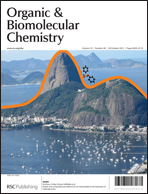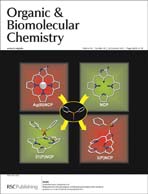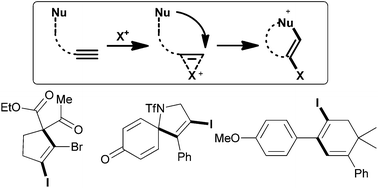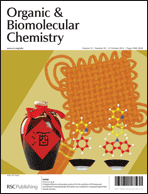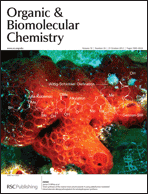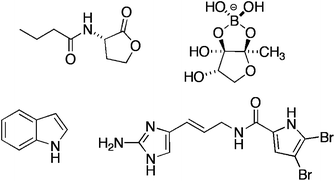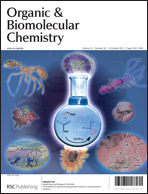This month sees the following articles in Organic & Biomolecular Chemistry that are in the top ten most accessed:
Recent progress of core-substituted naphthalenediimides: highlights from 2010
Sheshanath V. Bhosale, Sidhanath V. Bhosale and Suresh K. Bhargava
Org. Biomol. Chem., 2012, 10, 6455-6468
DOI: 10.1039/C2OB25798J
A new N-imidazolyl-1,8-naphthalimide based fluorescence sensor for fluoride detection
Junqi Wang, Lingyun Yang, Chen Hou and Haishi Cao
Org. Biomol. Chem., 2012, 10, 6271-6274
DOI: 10.1039/C2OB25903F
Asymmetric organocatalytic diboration of alkenes
Amadeu Bonet, Cristina Sole, Henrik Gulyás and Elena Fernández
Org. Biomol. Chem., 2012, 10, 6621-6623
DOI: 10.1039/C2OB26079D
Transition metal-catalyzed fluorination of multi carbon–carbon bonds: new strategies for fluorinated heterocycles
Guosheng Liu
Org. Biomol. Chem., 2012, 10, 6243-6248
DOI: 10.1039/C2OB25702E
π-Fused bis-BODIPY as a candidate for NIR dyes
Mitsunori Nakamura, Hiroyuki Tahara, Kohtaro Takahashi, Toshi Nagata, Hiroki Uoyama, Daiki Kuzuhara, Shigeki Mori, Tetsuo Okujima, Hiroko Yamada and Hidemitsu Uno
Org. Biomol. Chem., 2012, 10, 6840-6849
DOI: 10.1039/C2OB25930C
Enantio- and diastereocontrolled conversion of chiral epoxides to trans-cyclopropane carboxylates: application to the synthesis of cascarillic acid, grenadamide and L-(−)-CCG-II
Pradeep Kumar, Abhishek Dubey and Anand Harbindu
Org. Biomol. Chem., 2012, 10, 6987-6994
DOI: 10.1039/C2OB25622C
From biomass to medicines. A simple synthesis of indolo[3,2-c]quinolines, antimalarial alkaloid isocryptolepine, and its derivatives
Maxim G. Uchuskin, Arkady S. Pilipenko, Olga V. Serdyuk, Igor V. Trushkov and Alexander V. Butin
Org. Biomol. Chem., 2012, 10, 7262-7265
DOI: 10.1039/C2OB25836F
Chiral phosphine-catalyzed asymmetric allylic alkylation of 3-substituted benzofuran-2(3H)-ones or oxindoles with Morita–Baylis–Hillman carbonates
De Wang, Yuan-Liang Yang, Jia-Jun Jiang and Min Shi
Org. Biomol. Chem., 2012, 10, 7158-7166
DOI: 10.1039/C2OB25694K
Diverted organic synthesis (DOS): accessing a new, natural product inspired, neurotrophically active scaffold through an intramolecular Pauson–Khand reaction
Goverdhan Mehta, Ramesh Samineni, Pabbaraja Srihari, R. Gajendra Reddy and Sumana Chakravarty
Org. Biomol. Chem., 2012, 10, 6830-6833
DOI: 10.1039/C2OB26107C
Asymmetric synthesis of (+)-vertine and (+)-lythrine
Laëtitia Chausset-Boissarie, Roman Àrvai, Graham R. Cumming, Laure Guénée and E. Peter Kündig
Org. Biomol. Chem., 2012, 10, 6473-6479
DOI: 10.1039/C2OB25880C
Why not take a look at the articles today and blog your thoughts and comments below.
Fancy submitting an article to Organic & Biomolecular Chemistry? Then why not submit to us today or alternatively email us your suggestions.
 If you dug up a wooden artefact, how could you tell what type of tree it came from? French chemists have identified unique molecules from an ancient piece of oak that could hold the key.
If you dug up a wooden artefact, how could you tell what type of tree it came from? French chemists have identified unique molecules from an ancient piece of oak that could hold the key.










